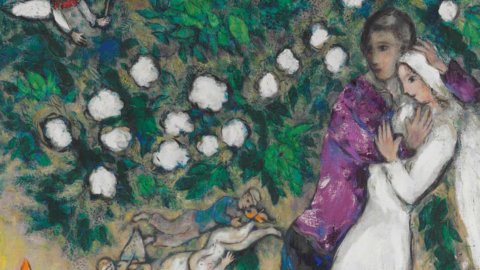Chagall with his always eternal bright smile, we can consider him an artist but above all an absolutely eclectic man. He loved to paint how to talk about music and immediately move on to entertaining with political speeches, to then return to his world where cows fly, lovers float above the roofs, roosters playing the violin and that Noah who sends the dove to reconnoiter to God who created man.
What mattered most to the artist was the irrational, that is, to escape from the world of machines. Just look at his paintings to be amused and at the same time moved by that sort of ability to merge the sublime with irony.
In his life he was always very generous, often donating his works, to Israel he donated several treasures including the Old Testament triptych, a very large tapestry that adorns the Knesset, the Palace of the Parliament, and to America the mosaic of Chicago's First Nationals Plaza, as well as two murals for the Metropolitan of New York. To Russia a considerable number of lithographs and other works and more…
In France, stained glass windows and its mosaics are found in churches, cathedrals and even in some universities. We only think of the ceiling of the Paris Opera, of that feast of colors that creates that magical sky in a circle of violinists, dancers and melodrama heroines.
He was born on July 7, 1887 in the Belarusian town of Vitebsk west of Moscow, where a large Jewish community, about 20 people, lived in wooden houses along the Dvina River. The first of nine children, of a Jewish father who worked in a herring warehouse, he soon began to paint, and what got him the most was to evoke everything represented by his hometown.
Then, on the advice of a friend, he left for St. Petersburg with only 27 rubles in his pocket, stolen from his father. He adapted to any job, and dedicated every free minute to painting. From this youthful period, the following appear on the canvases: scavengers, threshing floors, weddings and especially the roofs of Vitebsk, which admirers of Chagall well recognize.
To give a real turning point in his life was a lawyer, a certain Max Vinaver, who invited him to go to study in Paris, supporting the expenses and a monthly that he sent him. Arrived in 1910 he took lodgings in the dilapidated building The Beehive better known as the hive. Also Modigliani he had his studio in this place and on the very same floor as Chagall. Among the men of letters was the writer Blaise Cendrarif the poet Guillaume Apollinaire.
Struck by the colors used by the impressionists, Chagall began brushing the Seine and the drunks of Paris, the Eiffel Tower and the memories of home, such as uncle Neuč and the lovers embracing. But also a Paris with walking street lamps or Notre Dame crowned with a bouquet of flowers.
His first solo exhibition was organized in 1913 in Berlin in Germany, which brought him success and some money from the sale of the canvases. The following year he returned to Vitebsk where he married Bella Rosenfeld but he was unable to bring her to Paris as they were blocked by the October Revolution. In 1918, appointed commissioner of art for the province of Vitebsk, he wanted to celebrate the first year of the revolution by hanging huge festoons on the roofs of the houses. In 1922 he left Russia.
Back in Paris and thanks to a famous publisher and art dealer he started working on engravings like The dead souls by Gogol. He then illustrated the fairy tales of La Fountaine and others.
In 1941, as German troops ravaged Europe, Chagall fled to New York with his family; the works representing Nazi barbarism are from this period, as in the Yellow Crucifixion e The Fall of the Angel.
With Bella's death in 1944, distraught at the loss, he began making sets for the theater and designing costumes. The most beautiful work was undoubtedly the design for the costumes and the rainbow colored backdrops for The fire bird by Stravinsky.
Returning to France in 1948, he married Valentine called "Vava" Brodsky, of Russian descent and also Jewish.
In 1957 he wanted to go to Israel, where in 1960 he created a stained glass window for the synagogue of the Hadassah Ein Kerem hospital and in 1966 he designed a fresco for the new parliament. He continued to travel continuously, but never wanted to return to his native Vitebsk, nor to see those roofs that he had painted so much. He died in 1985 at the age of 97, in Saint-Paul-de-Vence.
Now his paintings enter the great collections of modern but also contemporary art alongside post war artists, among the most coveted subjects are married couples as in the case Les trois cierges (1939) which last May 15, 2017 in the Christie's auction in New York Price achieved a good 14,583,500 dollars.





